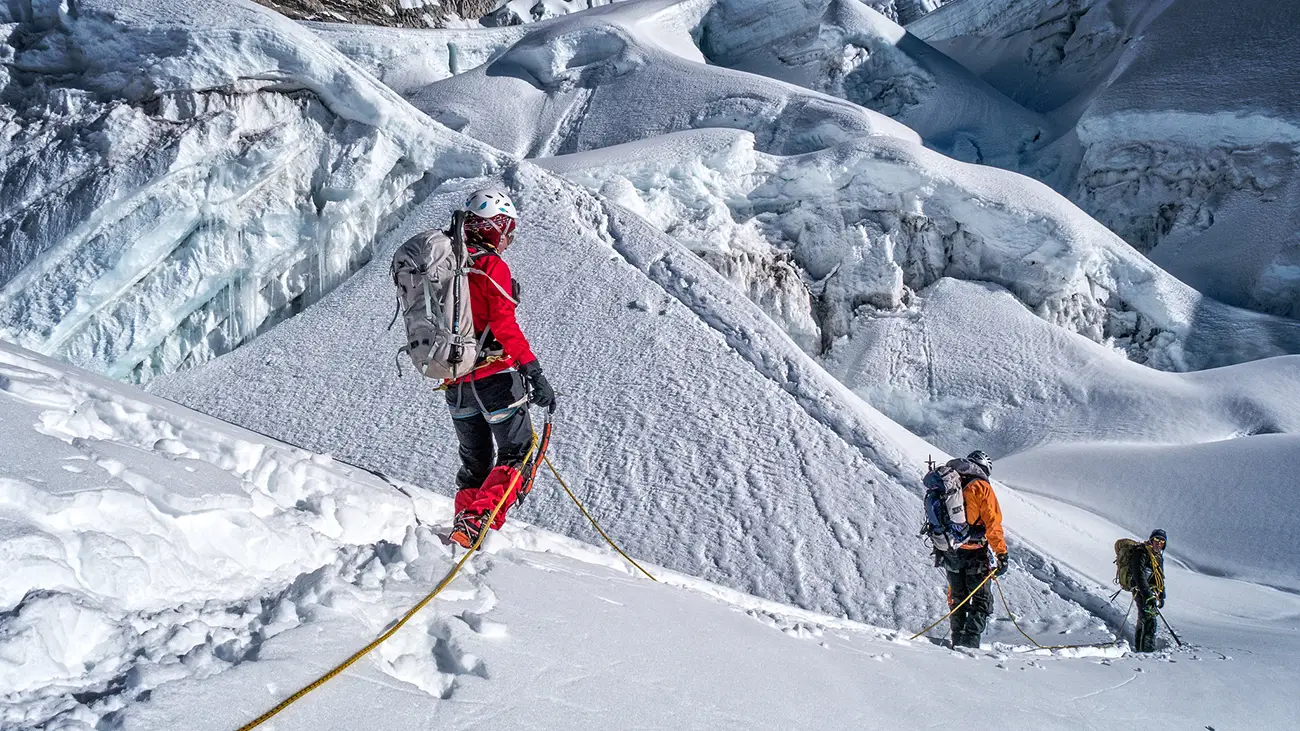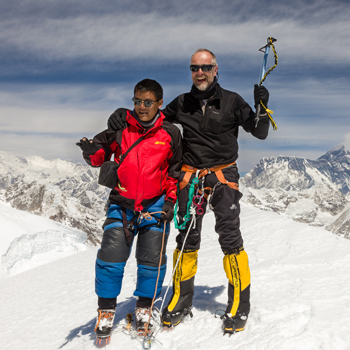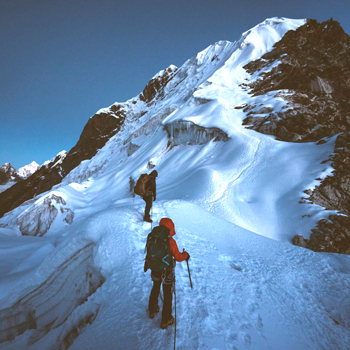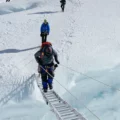Island Peak, or Imja Tse, beckons trekkers and climbers with its challenging ascents and stunning scenery. Nestled in Nepal’s Khumbu region, this 6,189-meter mountain presents a thrilling challenge for those eager to test their limits. A comprehensive Island Peak Packing List is vital for anyone determined to summit this peak, as it demands both trekking prowess and technical climbing skills.
The allure of Island Peak lies in its rigorous climb and the incredible views it offers. As climbers ascend, they are treated to magnificent vistas of Mount Everest, Lhotse, and Ama Dablam, enhancing the climbing experience with unforgettable landscapes.

Importance of Proper Preparation and the Right Gear
- Safety First: Proper gear is paramount for safety across varied terrains and altitudes. Include top-quality climbing harnesses, helmets, and boots designed for icy environments in your packing list.
- Weather Readiness: High altitudes bring unpredictable weather. Pack waterproof and windproof garments to navigate sudden climatic shifts.
- Health Considerations: The risk of altitude sickness and injuries is significant. Your list should contain altitude sickness remedies, a comprehensive first aid kit, and essential health supplies.
- Sustainability: It is crucial to choose eco-friendly gear. To reduce your environmental impact, select reusable water bottles and efficient gadgets.
- Efficiency: A lighter pack is more manageable. Carefully consider each item’s necessity and versatility to streamline your Island Peak Packing List.
Essential Gear for the Island Peak Climb
Preparing for a climb up Island Peak, also called Imja Tse, requires thorough attention to your Island Peak Packing List to ensure you are equipped for safety and success. Proper gear enhances the climb and provides comfort and safety throughout the expedition. Here is an essential breakdown of the gear and clothing you should include.
Climbing Equipment Essentials
- Ice Axes: Select a lightweight, technical ice axe that provides excellent grip and balance, ideal for navigating the steep icy slopes of Island Peak.
- Crampons: Choose sturdy, mountaineering crampons that fit your boots perfectly. Ensure they are correctly adjusted and in top condition to tackle icy surfaces.
- Harness: Ensure your climbing harness fits well. It should adjust to different layer thicknesses and have gear loops for attaching additional climbing tools.
- Ropes: Invest in high-quality, dry-treated ropes. These are crucial as they repel water and prevent freezing, ideal for frigid, high-altitude conditions.
- Additional Tools: Pack essential tools like carabiners, a belay device, and slings, which are crucial for ensuring your safety during rope climbing.
Clothing Layers
- Base Layer: To stay dry, begin with a moisture-wicking base layer. Choose merino wool or synthetic fibers, as they manage moisture effectively.
- Middle Layer: Include a breathable insulating layer, such as fleece or down, to maintain warmth without overheating.
- Outer Layer: Choose a breathable, windproof, and waterproof outer layer. A quality hard shell jacket and pants are crucial to protect against harsh weather conditions.
- Head and Hand Protection: Bring a warm beanie or balaclava and UV-protective sunglasses to shield yourself from harsh sun and cold. Pack waterproof gloves and a thinner pair for less severe weather.
- Footwear: Wear insulated, high-altitude mountaineering boots that are well-suited for your crampons and are already broken in to avoid blisters.

Technical Equipment for the Island Peak Climb
When tackling the climb up Island Peak, also known as Imja Tse, it’s essential to focus on the technical equipment part of your Island Peak Packing List. This mountain demands physical preparedness and the right technical tools to navigate its challenging terrain safely. Here’s a detailed guide on what specific gear to carry and the standards for quality and safety.
Must-Have Technical Gear
- Fixed Ropes: These are vital for steep and icy sections with a higher risk of falling. Ensure the ropes are designed for climbing and can withstand harsh conditions.
- Carabiners: Include both locking and non-locking carabiners in your gear. These small but mighty tools are essential for quickly and securely attaching components, especially when wearing gloves.
- Helmet: Never climb without a helmet. Choose a climbing-specific helmet that fits well and protects against falling debris and bumps against rock faces.
Quality and Safety Standards
- Check Certifications: Ensure all your technical gear meets international safety standards. Look for UIAA or CE certification to ensure gear quality and reliability.
- Inspect Before You Pack: Always inspect your equipment before the climb. Check for any wear, tear, or damage that could compromise the gear’s integrity.
- Choose Trusted Brands: Invest in equipment from reputable brands committed to climbing safety. It ensures that your gear is reliable when it matters most.
- Seek Professional Advice: If unsure about your gear’s suitability, consult a professional. You can do this at your local climbing shop or through your climbing expedition leader.
- Update Regularly: Technology and standards in climbing equipment can change. To maintain safety, keep your gear updated and replace old or worn-out items.

Essential Footwear for Your Island Peak Climb
When gearing up to climb to Island Peak, selecting the proper footwear is critical to your Island Peak Packing List. Proper footwear affects your comfort, safety, and performance during the climb. This section will guide you in choosing the best boots for the ascent and suitable footwear for use around the camp.
Choosing the Right Climbing Boots
- High-Altitude Mountaineering Boots: Opt for boots designed explicitly for high-altitude climbing. These boots should offer excellent insulation to protect against extreme cold and be rigid enough to support crampons securely.
- Waterproof and Breathable: Ensure your boots are waterproof to keep your feet dry, essential in snowy conditions. Breathability is also crucial to prevent moisture from sweating, which can lead to cold feet.
- Fit and Comfort: Your boots must fit well. It means no pinching and ample room to wiggle your toes, even with thick thermal socks.
Secondary Footwear for Camps
- Insulated Camp Boots: Switching into insulated camp boots can provide much-needed relief and warmth for your feet after a day’s climb. These should be light enough for comfort yet warm enough for chilly campsite evenings.
- Traction Sandals or Shoes: A lighter pair of traction sandals or shoes can be helpful for inside your tent or walking around the campsite during better weather. They provide a break for your feet from the heavy boots.
The Importance of Breaking In Your Footwear
- Avoid Blisters and Discomfort: Wearing boots that are not well broken in can lead to blisters and sore spots, severely impacting your climbing experience.
- Enhance Flexibility and Fit: Breaking in your boots will soften them, allowing the material to mold to your feet, enhancing both the flexibility and the fit.
- Test Under Similar Conditions: Try to break in your boots under conditions similar to those you’ll face on the climb. It includes wearing the same socks and carrying a similar load if possible.
Navigation and Communication Essentials for Island Peak
A successful climb to Island Peak requires more than just physical preparedness and the right gear; you must also be equipped with reliable navigation and communication tools. It is essential to your Island Peak Packing List to ensure safety, direction, and the ability to reach out for help if necessary. Here’s a rundown of the crucial devices and accessories you should carry.
Essential Navigation Tools
- GPS Devices: Invest in a durable, reliable GPS device with accurate readings. This gadget will help you navigate complex routes and track your progress towards the summit.
- Maps: Always carry detailed topographic maps of the Island Peak area. Even with digital tools, the value of physical maps cannot be overstated, especially if electronic devices fail.
- Compasses: A traditional compass is a fail-safe navigation tool that doesn’t rely on batteries. Make sure you know how to use one alongside your map.
Essential Communication Tools
- Satellite Phones: A satellite phone becomes crucial in remote areas where cell service is nonexistent. It enables communication with your base camp or emergency services, no matter where you are.
- Two-Way Radios: Two-way radios can effectively communicate between group members, especially if you need to split up for any reason.
Power Maintenance Tools
- Solar Chargers: Solar chargers can effectively keep devices powered during extended daylight at high altitudes.
- Extra Batteries: Always pack extra batteries for all your devices. Consider using devices with the same battery type to reduce the variety and number you need to carry.
- Battery Packs: High-capacity portable battery packs ensure that your electronic devices remain charged throughout your climb.
Health and Safety Essentials for Your Island Peak Adventure
When planning your ascent of Island Peak, prioritizing your health and safety is crucial, making them key elements of your Island Peak Packing List. Here’s a detailed guide on what to include for first aid and sun protection to keep you safe and healthy during your climb.
First Aid Essentials
- Essential First Aid Items: Your kit should contain bandages, antiseptic wipes, gauze pads, adhesive tape, and scissors. These items are vital for treating minor injuries.
- Medications for Altitude Sickness: Pack altitude sickness medications such as Acetazolamide (Diamox) to prevent and address altitude sickness. Seek advice from a healthcare professional before your trip for personalized guidance.
- Pain and Inflammation Management: Include medications like ibuprofen or aspirin to alleviate headaches and other pains that often accompany high-altitude excursions.
- Nausea Control: Carry anti-nausea medication, as nausea is a frequent and debilitating symptom of altitude sickness.
Sun Protection Measures
- High-SPF Sunscreen: Select a broad-spectrum sunscreen with an SPF of at least 30 to shield against intense UV radiation at high altitudes. Apply it liberally every two hours or more often if you are sweating heavily.
- Protective Lip Balm: Use a lip balm with SPF to keep your lips healthy and protected from sunburn.
- UV-Blocking Sunglasses: Invest in high-quality sunglasses that block 100% of UV rays. These are crucial for protecting your eyes from sun damage and the risk of snow blindness caused by UV reflection.
Additional Preparation Tips
- Expiration Date Verification: Check all medications and sunscreens for expiration dates before you set out on your climb.
- First Aid Training: You and your team need basic training. Being capable of addressing everyday medical situations can significantly influence the success of your climb.
- Strategic Packing: While it’s essential to be well-prepared, also consider the weight and bulk of your first aid and sun protection gear. Choose multi-use items whenever possible and pack only as much as you need for your trip.
Essential Nutrition and Hydration for Climbing Island Peak
Proper nutrition and hydration are paramount for anyone taking on the challenge of Island Peak, necessitating their inclusion in your Island Peak Packing List. The demands of high-altitude climbing require meticulous preparation of food and water supplies to ensure peak performance and safety.
Nutrition: Hydrating and Calorie-Rich Foods
- Calorie-Rich Snacks: Choose nuts, dried fruits, and energy bars that are high in calories and easy to eat on the go, providing quick bursts of energy.
- Complex Carbohydrates: Pack whole-grain bread, cereals, and pasta. These foods are crucial for sustained energy release and help you maintain endurance throughout your climb.
- Protein Options: Bring portable protein sources such as jerky, protein bars, or tuna or chicken packets. These are vital for muscle repair after climbing physical exertion.
- Electrolyte Supplements: Add electrolyte powders or tablets to your water to replenish minerals lost through sweat and prevent dehydration.
Water Purification Techniques
- Boiling Water: Boiling is a trusted method for purifying water. It effectively destroys pathogens, ensuring any water source is safe for consumption.
- Chemical Purifiers: Lightweight iodine or chlorine dioxide tablets can be utilized for water purification. These require some time before the water becomes drinkable.
- Mechanical Water Filters: Invest in a robust water filter to eliminate pathogens and particulates. Choose one that suits the type of water you expect to find.
- UV Purifiers: A portable UV purifier is a quick and effective way to sanitize water, killing bacteria and viruses without changing the water’s flavor.
Additional Considerations
- Efficient Packing: Strategically balance the weight and necessity of your food and water provisions. Pre-pack your meals to minimize space and avoid unnecessary waste.
- Test Your Equipment: Always test your water purification equipment before departure to ensure functionality and familiarity with its operation.
- Prepare for the Unexpected: Pack extra food and an alternative water purification method to safeguard against potential failures or delays during your climb.

Essential Miscellaneous Items for Your Island Peak Climb
As you prepare your Island Peak Packing List, don’t overlook the miscellaneous items that significantly enhance your climbing. These personal items and environmental considerations ensure comfort and convenience and adhere to responsible climbing practices.
Personal Essentials
- Toiletries: Include lightweight, biodegradable toiletries such as toothpaste, toothbrush, and soap. Choose compact sizes to conserve backpack space.
- Quick-Dry Towel: Essential for personal hygiene, a quick-dry towel is lightweight, dries quickly, and occupies minimal space, ideal for high-altitude adventures.
- Camera: Remember to pack a camera to capture the breathtaking landscapes of the Himalayas. Opt for a lightweight model or utilize a high-quality smartphone camera to reduce your carry weight.
Environmental Practices
- Trash Bags: Bring durable trash bags to remove all waste, adhering to the Leave No Trace principles. This effort helps maintain the natural environment’s integrity.
- Sustainable Practices: Adopt practices and products that minimize environmental impact, such as avoiding single-use plastics and ensuring all waste leaves the wilderness.
Packing Tips for Miscellaneous Items
- Pack Efficiently: Select items based on their necessity and weight. A lighter backpack makes for a more straightforward ascent.
- Organize Effectively: Utilize packing cubes or zip-lock bags to organize miscellaneous items efficiently and keep them accessible.
- Anticipate Various Conditions: Aim for minimalism but be prepared for different situations, such as changes in weather or personal care requirements.
Finalizing Your Island Peak Packing List: Checklist Summary and Efficient Packing Tips
As you prepare for your Island Peak adventure, pack everything you need. This final section provides a concise checklist summarizing all necessary items and offers tips on packing efficiently. By adhering to this guidance, you’ll optimize the weight and balance of your pack, enhancing your comfort and mobility during the climb.
Comprehensive Island Peak Packing List
Climbing Gear:
- Ice axes
- Crampons
- Climbing harness
- Ropes
- Carabiners, belay device, and slings
Clothing:
- Base layers (moisture-wicking)
- Insulating layers (fleece or down)
- Outer layers (waterproof and windproof)
- Beanie or balaclava and UV-protective sunglasses
- Gloves (waterproof and a thinner pair)
- High-altitude mountaineering boots
Technical Equipment:
- GPS device
- Maps and compass
- Satellite phone
- Solar charger and extra batteries
Health and Safety:
- First aid kit, including altitude sickness and anti-nausea medication
- Sunscreen, lip balm with SPF, UV-blocking sunglasses
Nutrition and Hydration:
- High-calorie snacks (nuts, dried fruits, energy bars)
- Electrolyte supplements
- Water purification methods (boiling equipment, chemical tablets, mechanical filters, UV purifiers)
Miscellaneous:
- Toiletries (biodegradable)
- Quick-dry towel
- Camera
- Trash bags for waste removal
Tips for Efficient Packing
- Strategize Your Load: Balance the weight across your pack to maintain stability and reduce strain. Heavier items should be closer to your back and centered.
- Utilize Packing Cubes: Packing cubes can classify your items, making them easier to find and manage. They also help compress clothes to save space.
- Consider Multi-use Items: When possible, choose gear that serves multiple purposes. This reduces the number of items you need to carry.
- Regularly Review and Adjust: As you pack, periodically reassess your list and what you’ve packed. Remove unnecessary items to minimize weight.
- Practice Packing: Before the trip, try packing your backpack on a trial basis. This will help you understand how to fit everything and identify any last-minute adjustments.
Conclusion: The Critical Role of Your Island Peak Packing List
Successfully climbing Island Peak is a demanding but fulfilling experience, and crafting a thorough Island Peak Packing List is crucial for your safety and success. Adequate preparation ensures you are equipped with all essential gear and supplies, empowering you to confidently manage the unpredictable nature of high-altitude environments.
Being meticulously prepared can significantly enhance your climbing experience, turning potential challenges into manageable obstacles. Every component of your gear list, from your technical equipment to your items, is vital for ensuring your climb is comfortable and safe. Careful gear selection and strategic packing are crucial to maintaining agility and focus throughout your expedition.
Always verify the latest weather forecasts and consult with local guides or experienced climbers before setting out. The dynamic weather on the mountain can shift unexpectedly, and insights from locals can be instrumental in fine-tuning your packing strategy, whether adding extra insulation for the cold or adjusting your nutrition and hydration plans.







